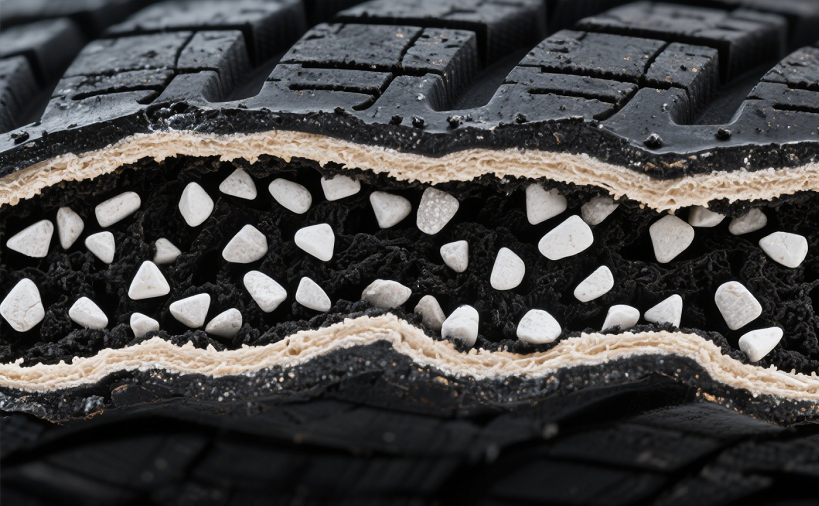Magnesiumoxid (Mgo) ist ein multifunktionaler Additiv in der Reifenproduktion, Seine Aufgaben erstrecken sich über mehrere Bereiche der Gummiverarbeitung und Reifennutzung. Seine Hauptfunktionen spiegeln sich in den folgenden Aspekten wider:

Die Rolle von Magnesiumoxid in Reifen
1. Regulierung der Vulkanisationsreaktion und Optimierung der Vulkanisationsleistung
- Vulkanisierungsaktivierung und -förderung: Magnesiumoxid kann synergistisch mit Vulkanisationsmitteln wirken (wie Schwefel) und Beschleuniger in Gummiformulierungen zur Aktivierung des Vulkanisationssystems, Beschleunigen Sie die Vulkanisationsreaktionsgeschwindigkeit, verkürzen die vulkanisation zeit, und die Produktionseffizienz verbessern. Gleichzeitig, Es kann die Vernetzungsdichte der Vulkanisation erhöhen, Dadurch bilden Gummimoleküle eine stabilere dreidimensionale Netzwerkstruktur, Dadurch wird die Kraft erhöht, Elastizität, und Verschleißfestigkeit von Reifengummi.
- Anti-Verbrennungsschutz: Beim Mischen und Formen von Gummi, Magnesiumoxid kann eine vorzeitige Vulkanisation hemmen (bekannt als “sengend”), Verhindert, dass Gummi aufgrund des Temperaturanstiegs während der Verarbeitungsphase vorzeitig aushärtet. Dies gewährleistet die Formstabilität verschiedener Reifenkomponenten (wie z.B. Lauffläche, Seitenwand, und Cordschicht) und reduziert die Ablehnungsquote.
2. Neutralisierung saurer Substanzen und Schutz der Gummileistung
- Reifengummi (insbesondere Materialien wie Butylkautschuk und halogenierter Butylkautschuk, die in Schläuchen oder Innenauskleidungen verwendet werden) kann Spuren saurer Substanzen erzeugen (wie zum Beispiel Halogenwasserstoff) aufgrund thermischer Zersetzung während der Verarbeitung oder Verwendung. Als Säureneutralisator, Magnesiumoxid kann diese sauren Bestandteile effektiv absorbieren, Sie verhindern, dass sie Gummi-Molekülketten korrodieren oder die Metallgerüstmaterialien beschädigen (wie zum Beispiel Stahlseile) im Reifen. Dadurch bleibt die chemische Stabilität und Haltbarkeit des Gummis erhalten, Verlängerung der Lebensdauer des Reifens.
3. Verbesserung der mechanischen Eigenschaften und Haltbarkeit von Gummimaterialien
- Verbesserung der Hitzebeständigkeit und Anti-Aging-Leistung: Durch den Zusatz von Magnesiumoxid kann die thermisch-oxidative Alterungsbeständigkeit von Gummi erhöht werden, wodurch Reifen weniger anfällig für Verhärtung werden, knacken, oder Elastizitätsverlust aufgrund thermischer Verschlechterung beim Fahren bei hohen Temperaturen (wie z. B. langfristiger Hochgeschwindigkeitsbetrieb). Dies ist besonders wichtig für Teile des Reifens, die direkt Reibung und hohen Temperaturen ausgesetzt sind, wie die Lauffläche und die Pufferschicht.
- Verbesserung der Haftungsleistung: In Teilen des Reifens, wo sich die Cordschicht befindet, Gürtelschicht, usw., werden mit Gerüstmaterialien kombiniert (Stahldrähte, Fasern), Magnesiumoxid kann die Haftung zwischen Gummi und Gerüstmaterialien verstärken, verhindert Delamination oder Abblättern, und Verbesserung der strukturellen Integrität und Schlagfestigkeit des Reifens.
4. Anpassung an gezielte Anforderungen unterschiedlicher Reifenkomponenten
- Karkasse und Cordschicht: Durch Optimierung der Vulkanisation und Verbesserung der Haftung, Die Ermüdungsfestigkeit der Karkasse wird verbessert, um sie an wiederholte Verformungen während der Fahrzeugfahrt anzupassen.
- Innenfutter: Nutzung seiner säureneutralisierenden Fähigkeit und chemischen Stabilität, Es gewährleistet die Luftdichtheit des Innenliners (Verringerung der Luftleckage) und widersteht Erosion durch interne Gase und äußere Umgebungen.
- Pufferschicht: Passt die Vulkanisationsgeschwindigkeit an die Verarbeitungstechnologie an, und verbessert gleichzeitig die Zähigkeit des Materials, um die Spannungsübertragung zwischen Lauffläche und Karkasse zu verringern.
Zusammenfassung
Magnesiumoxid in Reifen spielt mehrere Rollen, beispielsweise bei der Regulierung von Vulkanisationsreaktionen, Neutralisierung saurer Substanzen, und Verbesserung der Materialleistung. Es gewährleistet nicht nur die Stabilität des Reifenproduktionsprozesses, sondern verbessert auch die Festigkeit deutlich, Haltbarkeit, Hitzebeständigkeit, und strukturelle Integrität der fertigen Reifen, Damit ist es ein unverzichtbarer Schlüsselzusatz in Reifenkautschukformulierungen.
 Magnesium oxid_magnesium hydroxid_magnesium carbonathersteller-zehui Gruppe
Magnesium oxid_magnesium hydroxid_magnesium carbonathersteller-zehui Gruppe


